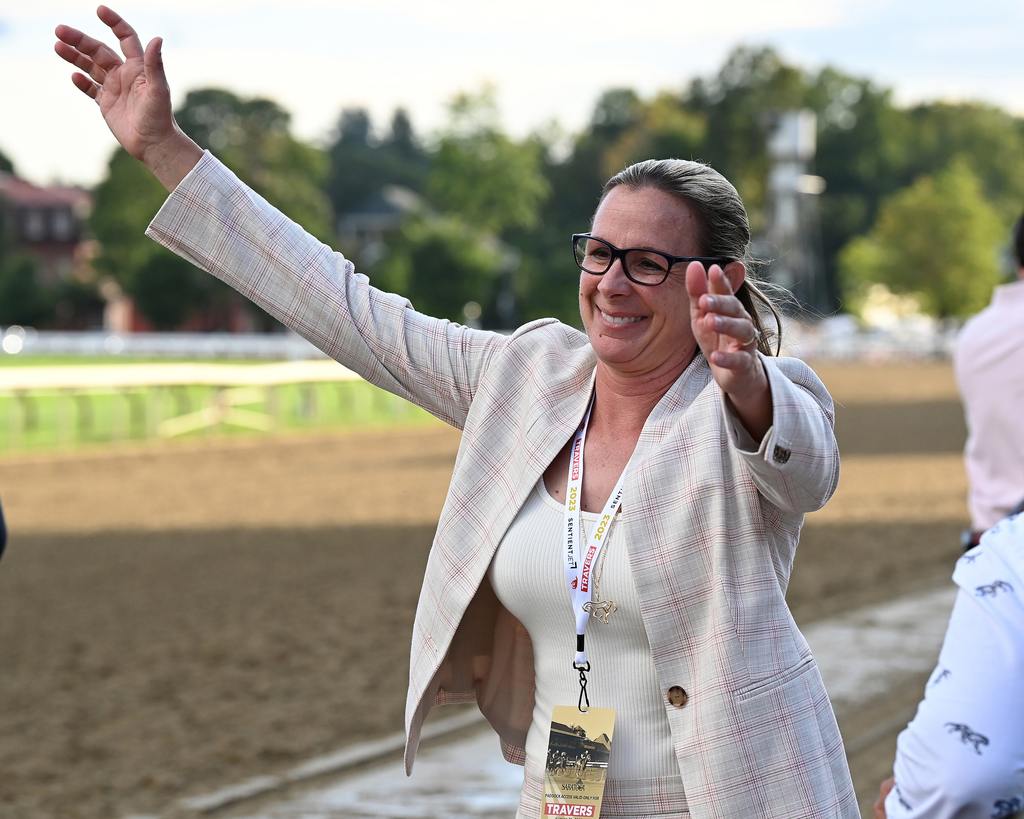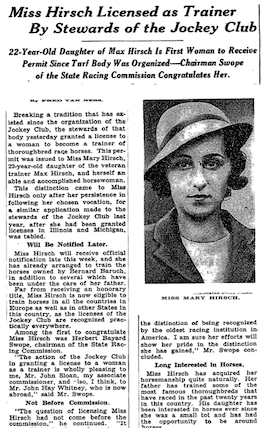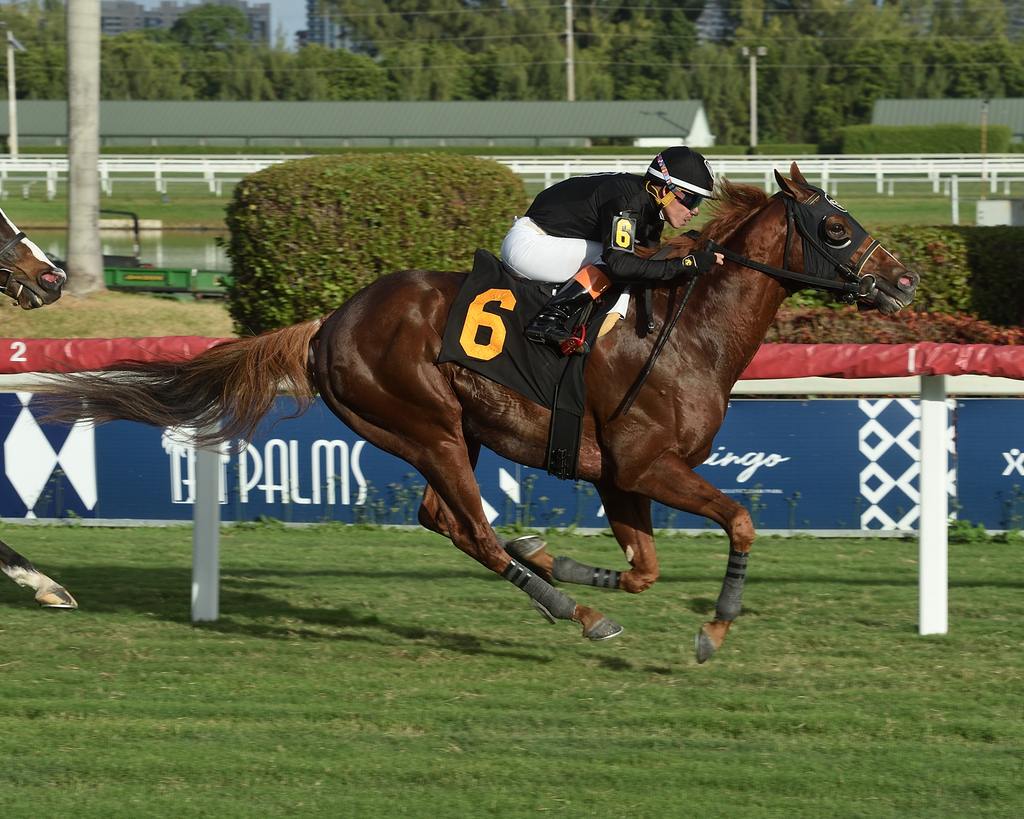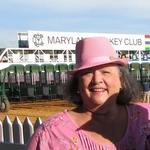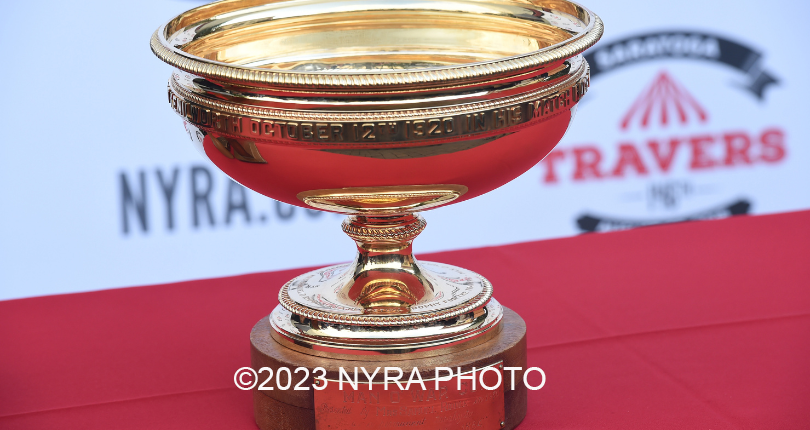
The coveted Travers Trophy won by only two female trainers in history: 1938 by Mary Hirsch, 2023 by Jena Antonucci. (NYRA Photo)
Barnstormers, Part One: Mary Hirsch and Jena Antonucci and the Travers Stakes
The Owners, The Horses, The Jockeys and The Race
By Maribeth Kalinich
This is a story about two trainers. And two horses. And two jockeys. And two owners. Heck, this story grew eight legs. And five parts.
Upon my attempt to write about Mary Hirsch, the first woman to win the Travers Stakes, I saw many similarities between Mary and Jena Antonucci. I was compelled to include Jena in the story.
As the story evolved, I saw how important the owners were to the outcome. They too must be included.
Two Hall of Fame jockeys, one having more fun than should be legal this year. My fingers were dancing on the keyboard.
This is a story about the 1938 and 2023 Travers Stakes, the horses, and the people. Although in two different eras some things never change. Women are still breaking ground and making history.
Here is part one.
THE TRAINERS
Two Thoroughbred trainers, both grew up in barns, both made history, both won the Travers Stakes, and both are women. And they both busted the barns wide open.
Mary Hirsch, daughter of Max Hirsch, was the first woman to win the Travers Stakes in 1938. This was the time when men like her father and War Admiral’s owner Sam Riddle ruled the roost in horse racing.
A consummate groundbreaker, the younger Hirsch was also the first woman to obtain a Thoroughbred trainer’s license in 1934, clearing a path for women like Jena Antonucci 89 years later to walk in her boots.
Mary Hirsch was the first woman to saddle a Triple Crown starter, in the 1937 Kentucky Derby. Jena Antonucci was the first woman to win a Triple Crown race.
Jena Antonucci, the first woman to win the Belmont Stakes followed in Mary Hirsch’s footsteps to win the Travers 85 years later, only the second female trainer to do so.
Both had similar starts in relation to horses. They ate, slept, and breathed horses.
With her father’s grand stable and the family living in a cottage on the grounds of Belmont Park, Mary had grown up around horses.
The young Hirsch “made a habit of keeping trainers’ hours. She got up at dawn to watch the workouts, helped her father’s stablemen feed the horses [and] grew to know as much about such matters as Max Hirsch himself,” Time Magazine reported in 1935.
As a young girl, she rode jumpers but always had her eye on training. Although her father tried to discourage her interest, her passion never waned, and Max Hirsch relented.
The elder Hirsch even grew to respect his daughter’s talent as a horsewoman. The New York Times wrote, “her father thinks enough of her judgement to consult with her.”
Jena grew up in South Florida, where she took part in her first horse show on a lead line before she was 4 years old. Before she transitioned to Thoroughbred trainer, she had a successful career in the hunter/jumper ring.
When she was about 10 or 11, her grandparents in New York became Thoroughbred racehorse owners. Their retired racehorses often ended up with Jena’s hunter/jumper trainers to prepare for their second careers. After graduating high school, Jena began retraining and selling off-track Thoroughbreds herself.
Jena said while retraining the Thoroughbreds that came from her grandparents’ stable, she learned about the mentality of the breed. The fact that they were very intelligent, and they needed to be mentally challenged, stimulated.
Mary Hirsch
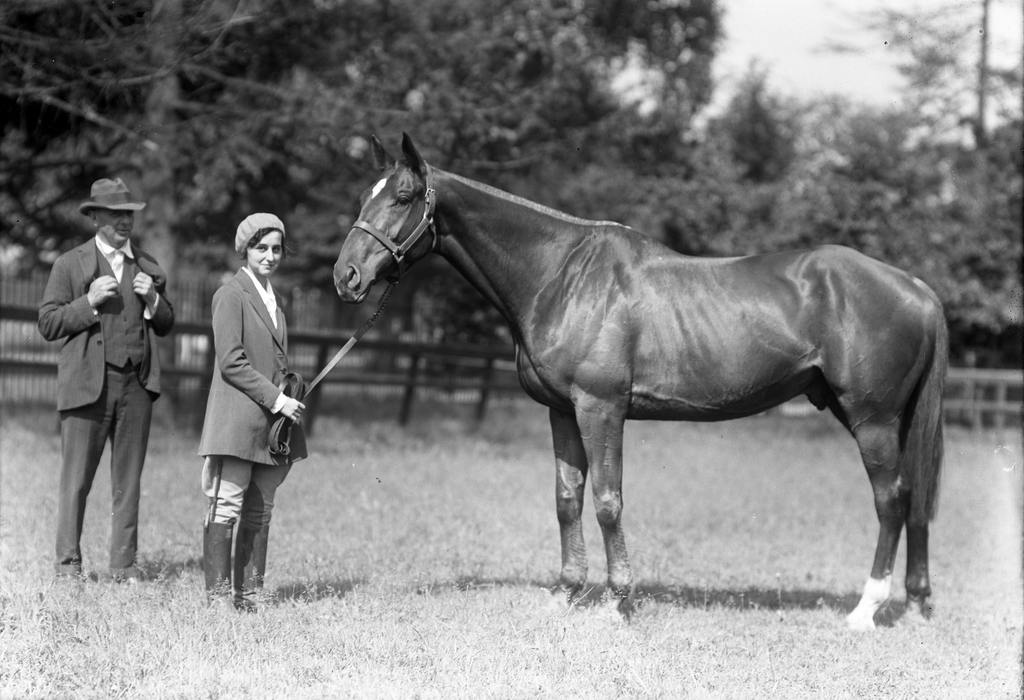
Mary Hirsch spent several years as her father’s apprentice conditioning horses such as Morton L. Schwartz’s Gusto who won the 1932 Jockey Club Gold Cup and Arlington Classic.
In 1933, she decided to apply for her own trainer’s license with The Jockey Club which was then headquartered in New York.
The Jockey Club being 50 older men unaccustomed to female competition tabled Mary’s application.
Mary being a Hirsch obtained a license to train in Illinois and Michigan and proceeded to rack up wins.
The following year she returned to The Jockey Club with a solid record as a trainer and they finally granted her a licensure. Hirsch was 22 years old and could now train anywhere in the United States and Europe.
Upon being granted the groundbreaking license, Hirsch told Time: “I have a few horses which can run fast. If they escape illness and injury, I think they can win in New York this spring.”
Max Hirsch would win his first Travers Stakes that same year with Morton Schwart’s Observant.
Mary Hirsch would be training the horses of owner Bernard Barusch among others.
In 1935, Hirsch won ten races with earnings of $10,365. ($231,276 in 2023 dollars). By 1936, she’d increased her stats to 17 wins and $18,575, and that summer at Saratoga, Hirsch became the first woman to train a winner there, saddling a gelding named No Sir to victory in the Diana Stakes.
As a 2-year-old, No Sir also won the East View Stakes and was second in the Florida City Purse, Walden Handicap, Endurance Handicap, and Saratoga Sales Handicap.
In his sophomore year, Hirsch had more ambitions for her colt, prepping him for a start in the 1937 Kentucky Derby.
The Bahamas Stakes, run annually in January at Hialeah, was a seven-furlong race on dirt and considered the first important test of the calendar year for newly turned three-year-olds. The race was used by prospective U.S. Triple Crown contenders as a stepping stone to the Everglades and Flamingo Stakes at the Hialeah.
No Sir would win the Bahama Stakes, ridden by California-based jockey Jack Westrope. Westrope, at age 15 while still officially an apprentice jockey, was the leading rider in the U.S. for 1933.
Hirsch’s colt would go on to place second in the Bahama over Eli Yale and Sceneshifter, the full brother to Champion Stagehand. No Sir finished second to Court Scandal in the Flamingo.
“With ordinary luck and a good ride my horse can win [the Kentucky Derby],” she told media in late April 1937. “No Sir has worked well since he came to the Downs and has shown he can go the Derby distance. He has a world of early foot and I think can hold his own in the early stages against War Admiral and Pompoon when the three of them probably will be out there fighting for the lead.
“Yes, sir. No Sir has plenty of heart.” Hirsch said.
Plenty of heart was not enough to beat that formidable field and No Sir finished 13th.
No Sir did not run in either the Preakness or the Belmont Stakes.
At four in 1938, he finished third behind Piccolo and Court Scandal in the McLennan Memorial Handicap.
At six in 1940, No Sir won the Inquisitor Handicap.
At seven in 1941, he was second in the Coral Reef Purse 2nd. Division and was third in the Orange Bowl Handicap.
1938 would be Mary’s year, a year in which she won 18 races and $26,210, “a record not equaled by scores of men trainers,” wrote Charles B. Parmer in “For Gold and Glory,” a history of American Thoroughbred racing published in 1939. The author noted he not only admired Hirsch as a trainer but for what a good sport she could be.
Hirsch would take over training Anne Corning’s colt Thanksgiving in 1938 for his 3-year-old campaign. A former trainee of her father Max, Thanksgiving had survived a lightening strike at the elder Hirsch’s Saratoga barn and still gone on to win the Hopeful in his juvenile season.
Thanksgiving would run well for Mary. Although he wasn’t always the winner, when he did lose it was by remarkably small margins and he was breaking track records. All preparing him for the ultimate race. The Travers Stakes.
With Eddie Arcaro aboard Thanksgiving’s winning time of 2:03.60 was the fastest time in 18 years since Man o’ War set the record in 1920 at 2:01.80. For the win, Thanksgiving earned $14,400 of the $20,000 purse, and Hirsch took home $1,000 as the conditioner.
Travers Stakes Time Records
Arcaro would best Thanksgiving’s record at 2:03.40 aboard By Jimminy in the 1944 Travers. The following year Conn McCreary would take it down to 2:02.80 piloting Adonis to a Travers victory. But Man o’ War’s record still stood untouched until the 1960s.
Bill Shoemaker would guide Jaipur to break the record in 1962. Then three would equal that record: Buckpasser in 1966 with Braulio Baeza up, Damascus in 1967, again under Schoemaker, and Arts and Letters in 1969, again under Baeza for trainer Elliot Burch.
In 1972, also for Burch, Baeza would break the record with Key To The Mint at 2:01.20.
The LeRoy Jolley trainee Honest Pleasure knocked a full second off the record in 1976 under Craig Peret.
Then Jolley’s General Assembly would hit the two-minutes flat mark with Jacinto Vasquez in the irons in 1979.
That record stood until 2016 when Arrogate with Mike Smith up smashed the record at 1:59.36.
She was 25 years old and the first woman trainer to win the Travers, accomplishing the feat with a horse that was lucky to be alive.
In 1939, Thanksgiving propelled Mary Hirsch into the history books again as the only female trainer to ever win the Philadelphia Handicap.

Hirsch’s training career was relatively brief despite her groundbreaking success.
In 1940, she married Charles McLennan, who was at the time racing secretary at Hialeah Park, Havre de Grace, Keeneland, Suffolk Downs, Pimlico, and Washington Park.
Retiring after marriage, Hirsch turned her horses over to her father and brother.
Mary focused her energies on the care of her two children with McLennan but her passion for horses and racing never dissipated. When her youngest child entered school in 1949, she returned to the track as an owner. With the same intensity and enthusiasm, Hirsch took over the management of Chinella, a King Ranch yearling given to her by her father.
There is little information on Mary in the mid-century.
Mary and her husband had bred horses at their Cowpen Farm near Towson, Md., until just before his death in 1971. Mary died in 1976.
“Her dad was a tough act to follow,” son, Charles McLennan Jr., told the Lexington Herald-Leader ‘s Maryjean Wall in 2000. “It was a man’s world at the time.”
Although no one could tell Mary Hirsch that.
A story recounted in Charles B. Parmer’s book was that one of Hirsch’s horses had lost a race and the newspapers said the jockey had given him a poor ride.
Mary climbed the stairs into the press box and said: “You chaps are all wrong. The boy rode to my orders — the horse just couldn’t make it.”
Jena Antonucci
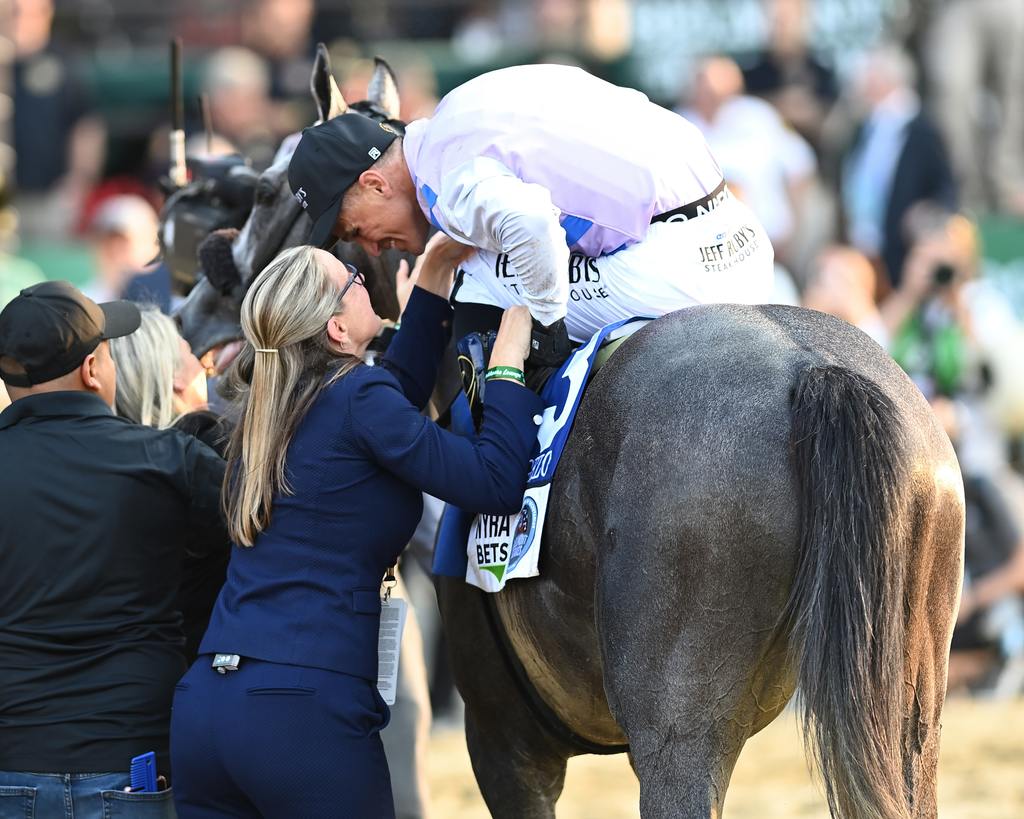
Jena Antonucci rode on the hunter/jumper circuit up to the USEF level. She also gave lessons and retrained off-the-track Thoroughbreds. But there was something calling her to the track.
Even after Antonucci transitioned into the Thoroughbred racing industry in 2000, off-track horses continued to be a part of her career trajectory.
She began breaking and training young horses at D. Wayne Lukas’ Padua Stables in Ocala, Florida, where she helped owner Satish Sanan launch an aftercare program to retrain retired racehorses in new disciplines.
Later, Antonucci joined the board of the Florida TRAC program to continue to assist horses in finding their next career after racing.
Antonucci eventually opened her own facility in Florida, Bella Inizio Farm, where she initially specialized in breeding stock but transferred into breaking and developing young horses.
In 2010, the same year she rode in her last USEF-level show, Antonucci got her trainer’s license. The transition to becoming a trainer was a natural one. Antonucci said she understood the complexities of the Thoroughbred.
“Horses are naturally pack animals and that is where their competitiveness on the track comes from. Why they like to run with other horses,” she would say.
Her first win would come March 7, 2010, at Tampa Bay Downs on her second start with Irish Wildcat who also got his first win that day.
Jena and Irish Wildcat would get a second place and another win by April 23.
In 2012, Antonucci’s career would start to take off when she moved her operation to New York boosting her stable and hitting the board collecting wins.
The horsewoman hit the $1 million mark in earnings in 2013. Primarily thanks to Five Star Mamma.
Five Star Mamma raced 22 times and earned $425,913 hitting the board at 75%. After being under several trainers, Antonucci took over conditioning of the Five Star Day mare after her May 4th fifth-place finish at Churchill Downs in 2013.
Trained by Charles Dickey, the bay filly won her debut June 10, 2011, as a 2-year-old at Churchill Downs, followed up with a second in the Grade 3 Debutante also at Churchill Downs. Five Star Mamma, under new ownership, transitioned in her next start to trainer John Terranova II and went on to rack up a few second, third, and fourth-place finishes and a win at Parx in an Allowance.
With the new ownership of Summerwind Farms and Half Hollow Racing, Antonucci took over Five Star Mamma’s conditioning in June 2013 as the stalwart mare continued collecting fourth places with a third in the Shine Again at Saratoga. Then, after winning an Allowance at Belmont, she hit a streak of wins.
The Chip Stakes earning Black Type at Aqueduct. The Lady in Waiting Penn National.

The granddaughter of Nureyev out of Mamma In Law, went on to a second in the Willa On the Move at Laurel Park, second in the Grade 3 Hurricane Bertie and third in the Grade 2 Inside Information, both at Gulfstream Park, and third in the Grade 3 Vagrancy at Belmont.
With her trainees and herself gaining confidence on the track, Antonucci split her time between Florida’s Gulfstream Park and New York tracks with a few trips to Parx and Penn National in 2014.
Jena had new maidens to teach and train, her sophomores, stellar stakes mare, Five Star Mamma, and a horse she was trying to move up to stakes company, Predicting, a 3-year-old Visionaire colt.
There were other stars in her stable producing. Streets of Fire, Currency Union, Wisdom of Oz, Captain Toews, Madame Prosecutor who had been particularly consistent.
In 2015 she collected $627,239 in earnings and did it the old-fashioned way. None was from stakes. Antonucci made 250 starts with 19 firsts, 28 seconds, and 30 thirds that year.
In 2016, Antonucci earned over $900,000 from 232 starts. And she had her trusted trainees such as Wisdom of Oz and stakes horses in the barn like Doctor J Dub.
Winning For Sarah was another that stayed just on the bubble.

A tenacious sprinter still as a 6-year-old, Doctor J Dub took the Bob Umphrey Turf Sprint at Gulfstream Park in July and the $300,000 Grade 3 Turf Monster at Parx in September giving Antonucci her first graded stakes.
A 2-year-old son of Distorted Humor, Gemonteer, was in the spotlight in 2017.
Breaking his maiden on debut the gelding finished second in a starter optional claiming race, then won the Not Surprising Stakes, both at Gulfstream Park.
A trip north to Saratoga for the Grade 2 National Museum of Racing Hall of Fame proved a bit heady for the gray as he finished ninth. But he would bounce once back in Florida with a second in the Bear’s Den and third in the Showing Up.
A year-end trip in 2018 to Santa Anita for the Grade 2 Mathis Brothers Mile was a bit overwhelming even with Tyler Gaffalione aboard. Antonucci would give Gemonteer a layoff after that race.
Antonucci would bring Gemonteer back to Saratoga in July 2019 along with Gaffalione with a sixth-place result in an allowance. A change in rider to Emisael Jaramillo would produce a third place in an allowance optional claiming race at the Spa.
Then they headed to Kentucky Downs turf. And a new rider was brought on board. Javier Castellano. Gemonteer would win a $150,000 allowance optional claimer by a length over a deep field of 13.
With Jaramillo back up Gemonteer scored a follow-up win at Gulfstream Park to close out his 4-year-old season.
Antonucci trained Gemonteer until April 17, 2022, where he finished second by one length in a claiming race where he was claimed by trainer Gustavo Delgado. The same trainer that would a year later win the Kentucky Derby with Mage.
2022 was the same year another gray 2-year-old came to Antonucci’s barn. Arcangelo.
So, what’s next for Arcangelo? Antonucci said they’re not committed to any plans. “We’re thinking of the Breeders’ Cup, of course, but we’re just being in the present.”
When you win the Belmont Stakes and follow that up with the Travers Stakes staying in the present sounds like a pretty great place to be.
What makes a champion? Antonucci said champions aren’t made. “It comes from the breeding. It starts with the mamma in the field,” she said.
Jena is, of course, having her best year with over $2 million in earnings this year, bringing her career total up to just over $8 million.
With 84 starts this year, Antonucci has 14 wins, three with Arcangelo in the Peter Pan, Belmont Stakes and Travers. Also, seven second-place finishes and five third places, she has a total of 167 starts with 240 seconds and 232 third-place finishes.
Jena said the Hirsch family has reached out to her several times since Arcangelo’s Travers victory. She said about Mary Hirsch: “[Mary] owned her own space. She wasn’t going to let anything hold her back.”
The same can be said for Jena Antonucci.
